 |
 |
|
 |
|
 |
|  |
|  |
|
 |
|
 |
|  |
|  |
|
 |
The area_illumination option in POV-Ray 3.7 has given me the opportunity
to see how area_light distributes its points. File
area_illumination.jpg shows a simple 5x5 grid, scaled to a 2x2 fill
area. Fair enough.
But is it?
The points extend all the way to the edge of the fill area. This has
less than ideal consequences. File area_light_jitter1.jpg shows a
jittered 5x5 grid. The
light extends beyond the grid area. This is easy to correct in SDL,
however, using the formula:
axis_length * (number_of_points - 1) / number_of_points
Less easy to work around is the circular pattern. File
circular_light05.jpg shows the 5x5 circular pattern. The points are not
evenly spaced. The 17x17 pattern in circular_light17.jpg shows clearly
the uneven lighting effect, although I don't know how much visual impact
this has on a scene.
Post a reply to this message
Attachments:
Download 'area_illumination.jpg' (12 KB)
Download 'area_light_jitter1.jpg' (43 KB)
Download 'circular_light05.jpg' (12 KB)
Download 'circular_light17.jpg' (16 KB)
Preview of image 'area_illumination.jpg'
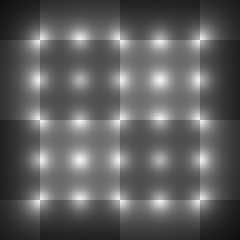
Preview of image 'area_light_jitter1.jpg'
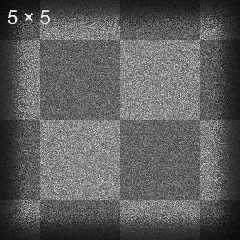
Preview of image 'circular_light05.jpg'
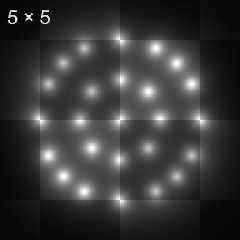
Preview of image 'circular_light17.jpg'
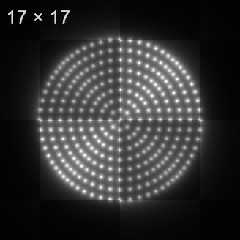
|
 |
|  |
|  |
|
 |
|
 |
|  |
|  |
|
 |
On 10/1/2016 11:09 AM, Cousin Ricky wrote:
> The area_illumination option in POV-Ray 3.7 has given me the opportunity
> to see how area_light distributes its points. File
> area_illumination.jpg shows a simple 5x5 grid, scaled to a 2x2 fill
> area. Fair enough.
>
> But is it?
>
> The points extend all the way to the edge of the fill area. This has
> less than ideal consequences. File area_light_jitter1.jpg shows a
> jittered 5x5 grid. The
> light extends beyond the grid area. This is easy to correct in SDL,
> however, using the formula:
> axis_length * (number_of_points - 1) / number_of_points
>
> Less easy to work around is the circular pattern. File
> circular_light05.jpg shows the 5x5 circular pattern. The points are not
> evenly spaced. The 17x17 pattern in circular_light17.jpg shows clearly
> the uneven lighting effect, although I don't know how much visual impact
> this has on a scene.
How do you evenly space points within a circle? Using a spiral? Or maybe
a hexagonal/triangular grid? I'm not sure it's possible.
http://stackoverflow.com/questions/33510979/generator-of-evenly-spaced-points-in-a-circle-in-python
Mike
Post a reply to this message
|
 |
|  |
|  |
|
 |
|
 |
|  |
|  |
|
 |
On 10/02/2016 03:57 PM, Mike Horvath wrote:
> How do you evenly space points within a circle? Using a spiral? Or maybe
> a hexagonal/triangular grid? I'm not sure it's possible.
Based on my jittered circular renders, just having the points in each
ring evenly spaced would be quite sufficient.
But taking a closer look at how the points are spaced, I believe I know
how they computed those positions. (I'd verify my guess by looking at
the code, but if I still had the mental stamina to do that, I'd be
*writing* POV-Ray.) A wild guess at why they chose to do it that way
would be to facilitate adaptive sampling.
Post a reply to this message
|
 |
|  |
|  |
|
 |
|
 |
|  |
|  |
|
 |
Cousin Ricky <ric### [at] yahoo com> wrote:
> On 10/02/2016 03:57 PM, Mike Horvath wrote:
> > How do you evenly space points within a circle? Using a spiral? Or maybe
> > a hexagonal/triangular grid? I'm not sure it's possible.
>
> Based on my jittered circular renders, just having the points in each
> ring evenly spaced would be quite sufficient.
>
> But taking a closer look at how the points are spaced, I believe I know
> how they computed those positions. (I'd verify my guess by looking at
> the code, but if I still had the mental stamina to do that, I'd be
> *writing* POV-Ray.) A wild guess at why they chose to do it that way
> would be to facilitate adaptive sampling.
I was going to guess what it might NOT be... perhaps not something to do with
degrees around each circle...?
Have you tried unequal numbers yet? I did and here's the result from 4 X 6.
You'll see it doesn't spread around evenly at all.
The formula or equation used would be interesting to know. I searched the 'net
for equations showing pictures of concentric circle points and nothing like this
found, plenty of evenly spaced points though. Maybe its peculiar to area_light
but sure would be interesting if it isn't a commonly known math equation and a
complex formula instead.
I was into those source files a long time ago, playing with tiny bits and
recompiling. Nothing ever achieved really by doing so. I just liked to see what
was going on with it more than anything.
Bob com> wrote:
> On 10/02/2016 03:57 PM, Mike Horvath wrote:
> > How do you evenly space points within a circle? Using a spiral? Or maybe
> > a hexagonal/triangular grid? I'm not sure it's possible.
>
> Based on my jittered circular renders, just having the points in each
> ring evenly spaced would be quite sufficient.
>
> But taking a closer look at how the points are spaced, I believe I know
> how they computed those positions. (I'd verify my guess by looking at
> the code, but if I still had the mental stamina to do that, I'd be
> *writing* POV-Ray.) A wild guess at why they chose to do it that way
> would be to facilitate adaptive sampling.
I was going to guess what it might NOT be... perhaps not something to do with
degrees around each circle...?
Have you tried unequal numbers yet? I did and here's the result from 4 X 6.
You'll see it doesn't spread around evenly at all.
The formula or equation used would be interesting to know. I searched the 'net
for equations showing pictures of concentric circle points and nothing like this
found, plenty of evenly spaced points though. Maybe its peculiar to area_light
but sure would be interesting if it isn't a commonly known math equation and a
complex formula instead.
I was into those source files a long time ago, playing with tiny bits and
recompiling. Nothing ever achieved really by doing so. I just liked to see what
was going on with it more than anything.
Bob
Post a reply to this message
Attachments:
Download 'area_light-coverage4x6circular.jpg' (18 KB)
Preview of image 'area_light-coverage4x6circular.jpg'
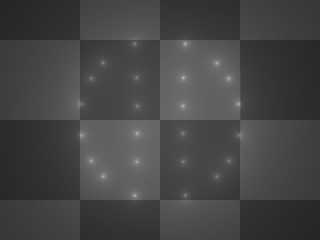
|
 |
|  |
|  |
|
 |
|
 |
|  |
|  |
|
 |
On 2016-10-03 12:50 AM (-4), omniverse wrote:
> Have you tried unequal numbers yet? I did and here's the result from 4 X 6.
I didn't realize you could do that! Probably because (so far) I've
never used a circular area light without also using orient.
Post a reply to this message
|
 |
|  |
|  |
|
 |
|
 |
|  |
|  |
|
 |
Cousin Ricky <ric### [at] yahoo com> wrote:
> On 2016-10-03 12:50 AM (-4), omniverse wrote:
> > Have you tried unequal numbers yet? I did and here's the result from 4 X 6.
>
> I didn't realize you could do that! Probably because (so far) I've
> never used a circular area light without also using orient.
And opposite you I had a bad habit of only using orient without circular,
thereby receiving a message about it being changed to a circular light in order
to do that.
I finally changed my ways. Well, not always.
Just always thought orient was doing something with the shadows and not the
light itself. In fact, now rendered this same thing from what I was showing a
picture of and find it appears as a point light source!
Hmmmm. How many years have I used POV-Ray...? 20-something! 8O (<face)
Bob com> wrote:
> On 2016-10-03 12:50 AM (-4), omniverse wrote:
> > Have you tried unequal numbers yet? I did and here's the result from 4 X 6.
>
> I didn't realize you could do that! Probably because (so far) I've
> never used a circular area light without also using orient.
And opposite you I had a bad habit of only using orient without circular,
thereby receiving a message about it being changed to a circular light in order
to do that.
I finally changed my ways. Well, not always.
Just always thought orient was doing something with the shadows and not the
light itself. In fact, now rendered this same thing from what I was showing a
picture of and find it appears as a point light source!
Hmmmm. How many years have I used POV-Ray...? 20-something! 8O (<face)
Bob
Post a reply to this message
|
 |
|  |
|  |
|
 |
|
 |
|  |
|  |
|
 |
Another. This has two 4X6 area lights, both with area_illumination and circular.
One light uses +3 for color, other -3 and rotated around same plane so they sort
of mesh together. Reason for the positive and negative "colors" is to display
the pattern better.
As you can see, they have differing shadow patterns due to not being truly
circular as was already mentioned. Or evenly spaced, however you want to
describe this.
I can only imagine this being of consequence for such close proximity objects,
as seen by the 2 spheres. One at corner where square array would have a point of
light, other in center.
And probably for very large area lights. A lot is going to depend on array
numbers, I'm sure.
I was about to say equally large numbers for points in the array might be better
but, aside from the performance hit render time-wise, considering the unevenness
of spacing maybe that would just enhance the diagonal concentration (heh, if
wasn't "circular". Whatever.) as was shown in those first pictures.
Bob
Post a reply to this message
Attachments:
Download 'area_light-coverage4x6circular2.jpg' (25 KB)
Preview of image 'area_light-coverage4x6circular2.jpg'
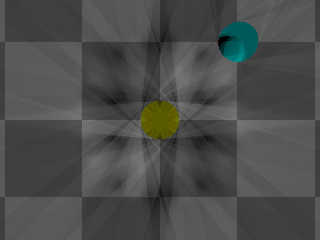
|
 |
|  |
|  |
|
 |
|
 |
|  |
|  |
|
 |
Am 03.10.2016 um 03:20 schrieb Cousin Ricky:
> But taking a closer look at how the points are spaced, I believe I know
> how they computed those positions. (I'd verify my guess by looking at
> the code, but if I still had the mental stamina to do that, I'd be
> *writing* POV-Ray.) A wild guess at why they chose to do it that way
> would be to facilitate adaptive sampling.
You're on the right track ;)
Post a reply to this message
|
 |
|  |
|  |
|
 |
|
 |
|  |
|  |
|
 |
Mike Horvath <mik### [at] gmail com> wrote:
>
> How do you evenly space points within a circle? Using a spiral? Or maybe
> a hexagonal/triangular grid? I'm not sure it's possible.
>
>
http://stackoverflow.com/questions/33510979/generator-of-evenly-spaced-points-in-a-circle-in-python
>
> Mike
Vogel's model of the Fermat spiral is very useful:
https://en.wikipedia.org/wiki/Fermat%27s_spiral
One of its greatest advantages is that you can choose an arbitrary number of
points.
There's also a version that covers a sphere. I'm still wondering how to /fill/ a
sphere using similar math, but I've failed at every attempt thus far and haven't
yet seen anyone anywhere manage to do it (yes, that's a challenge to everyone
because I'd really like to see it!).
Sam com> wrote:
>
> How do you evenly space points within a circle? Using a spiral? Or maybe
> a hexagonal/triangular grid? I'm not sure it's possible.
>
>
http://stackoverflow.com/questions/33510979/generator-of-evenly-spaced-points-in-a-circle-in-python
>
> Mike
Vogel's model of the Fermat spiral is very useful:
https://en.wikipedia.org/wiki/Fermat%27s_spiral
One of its greatest advantages is that you can choose an arbitrary number of
points.
There's also a version that covers a sphere. I'm still wondering how to /fill/ a
sphere using similar math, but I've failed at every attempt thus far and haven't
yet seen anyone anywhere manage to do it (yes, that's a challenge to everyone
because I'd really like to see it!).
Sam
Post a reply to this message
|
 |
|  |
|  |
|
 |
|
 |
|  |
|  |
|
 |
Am 10.10.2016 um 18:49 schrieb Samuel B.:
> Mike Horvath <mik### [at] gmail com> wrote:
>>
>> How do you evenly space points within a circle? Using a spiral? Or maybe
>> a hexagonal/triangular grid? I'm not sure it's possible.
>>
>>
http://stackoverflow.com/questions/33510979/generator-of-evenly-spaced-points-in-a-circle-in-python
>>
>> Mike
>
> Vogel's model of the Fermat spiral is very useful:
> https://en.wikipedia.org/wiki/Fermat%27s_spiral
Somewhat useless for adaptive area lights though. com> wrote:
>>
>> How do you evenly space points within a circle? Using a spiral? Or maybe
>> a hexagonal/triangular grid? I'm not sure it's possible.
>>
>>
http://stackoverflow.com/questions/33510979/generator-of-evenly-spaced-points-in-a-circle-in-python
>>
>> Mike
>
> Vogel's model of the Fermat spiral is very useful:
> https://en.wikipedia.org/wiki/Fermat%27s_spiral
Somewhat useless for adaptive area lights though.
Post a reply to this message
|
 |
|  |
|  |
|
 |
|
 |
|  |




![]()